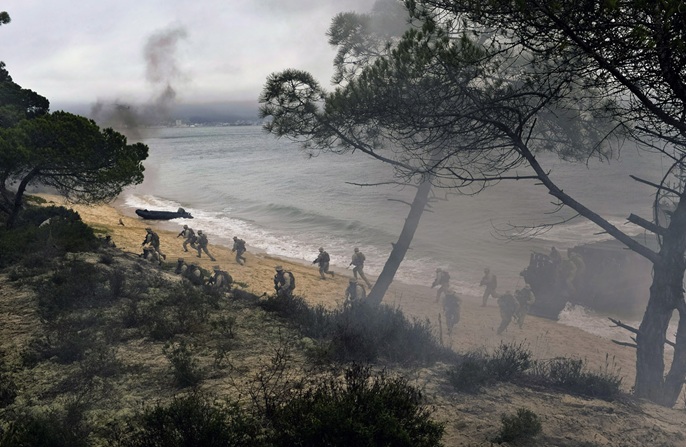Played out like a battlefield re-enactment, NATO representatives witnessed Royal Marines, from 45 Commando, simulate the storming of a beach in Troia, Portugal.
Working alongside US marines the men from Zulu Company, 45 Cdo, came ashore in landing craft from HMS Bulwark before retaking a peninsula from hostile enemies; while that was happening Portuguese marines fast roped from a helicopter onto a ship which they seized from pirates.
Following the action packed beach display the visitors were transferred to the Royal Navy’s flagship HMS Ocean for a sail past from several international warships and submarines which took part in NATO’s largest exercise in over a decade – Exercise Trident Juncture.
The distinguished visitor day rounded off an intense five week training period for nearly 3,000 British Armed Forces personnel from the Royal Navy, Army and RAF who have been taking part in Trident Juncture.
The exercise started in Italy before moving to Spain and eventually to Portugal with 36,000 military personnel from 230 military units and more than 60 ships from 30 nations tested in every location.
Lieutenant Colonel Tony Turner, Commanding Officer of 45 Commando Royal Marines, summed up the final day of the exercise saying: “What we did before the NATO Secretary General is take our most highly trained elements and demonstrate the level of preparedness we have attained during the exercise.
“It’s important to reassure our leaders that what we have been doing here is important and demonstrate that we have a truly credible capability to respond to evolving events on an international stage.”
The exercise also tested functions of NATO’s Very High Readiness Joint Task Force – or Spearhead Force – ahead of it becoming fully operational next year.
Heading up the maritime component of that Force will be Royal Navy Rear Admiral Tony Radakin.
Adm Radakin said: “During Trident Juncture I’ve had the privilege of commanding some 60 ships, submarines and aircraft as part of the largest and most ambitious NATO exercise in more than a decade.
“The scale and scope of this exercise involving forces on land, in the air and at sea has provided excellent training as I prepare to take Command of the Maritime NATO High Readiness Force next year, further reinforcing the UK’s commitment to the alliance.”
Both Bulwark and Ocean sailed with an international crew onboard made up of personnel from NATO, and non NATO partners, demonstrating the level of cohesion that exists between nations.
The Commanding Officer of HMS Ocean, Captain Steve Moorhouse, said: “Exercise Trident Juncture has been a significant event for the Royal Navy as it has operated on a huge scale across the Mediterranean with other units and nations.
“On the back of this exercise we have a greater understanding of the units we could operate with next year; that level of understanding and familiarity is hugely important, as should we be called upon then we know straight away what units, what ships, and which familiar faces will be operating, and where.
“This exercise has provided the foundation for what we hope will be a hugely successful NATO Response Force in 2016.”
But exercise Trident Juncture was also an opportunity for four variety of military helicopter to work side by side, including Royal Navy Wildcat and Merlin, Army Apache and RAF Chinook.
With four Wildcat deployed from 847 Naval Air Squadron, the exercise was thefirst time a full squadron had put the new generation of helicopter to the test.
Commander Graeme Spence, Commanding Officer of 847 NAS, as well as Commanding Officer of the Tailored Air Group on HMS Ocean, was pleased with the results.
He said: “The exercise gave us fantastic interaction with the Landing Forces as well as access to a wide range of NATO ships which has expanded our capability as aircrew working with aviation partners in different environments, landscapes and climates.
“Having successfully demonstrated our ability to work in the maritime environment we will have a quick turnaround before re- deploying to Norway for essential cold weather training and then later next year we plan to undertake desert training. All of this is required in order to fully generate the squadron to its full operational capability.”
Image Sourced: Royal Navy

